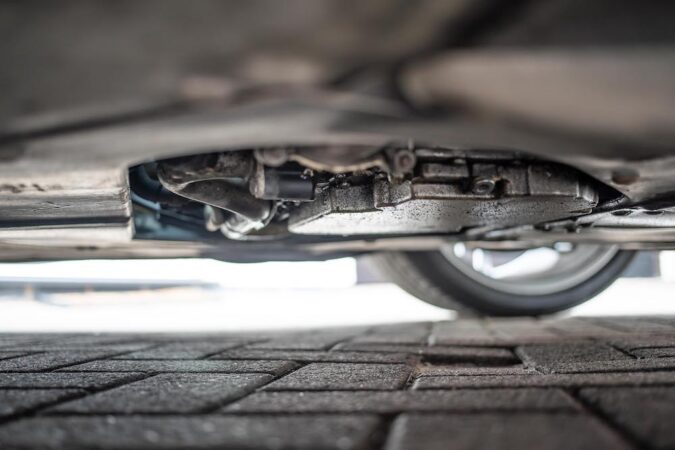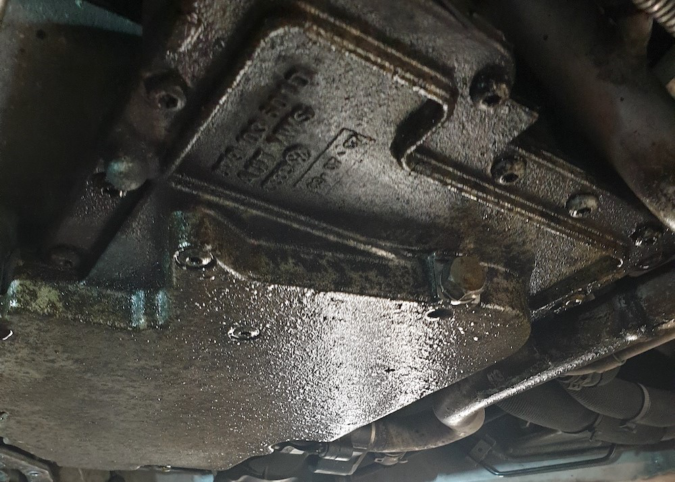A transmission fluid leak is a serious issue that you need to address. Although a small leak won’t cause immediate problems, it will lead to severe damage to the transmission if you don’t fix it. And needless to say, that’s going to be very costly to fix.
This post will help you to learn everything about transmission fluid leaks. From what causes them, what to do, the potential costs, and more. Here’s our table of contents to help you navigate:
Transmission Fluid: What Is It For?
The transmission fluid plays one or two roles depending on the transmission type. Its first role is to lubricate the components inside the transmission itself, similar to what your engine oil needs to do.
This is true for all types of transmissions. All of them, regardless of type, have a lot of moving parts within them that come into contact with each other. This creates a lot of friction, and as a result, creates a lot of heat.
The fluid is there to reduce the friction, resulting in less wear and heat in the components. This makes sure that the transmission works smoothly and lasts as long as possible.
In addition to the first role, it plays another role in automatic transmission which is to engage the torque converter. In a nutshell, the torque converter replaces the job of a conventional clutch and it’s what makes an automatic car creep forward when you’re in drive.
The torque converter has several parts, one of which is a turbine that connects to the transmission. When the impeller pumps fluid, it will spin the turbine which in turn spins the gears inside the transmission and drive the car. So, the fluid is also essential for driving the car in an automatic transmission.
If you want to learn more about automatic transmissions and their many variations, you can learn more in our article about automatic transmission parts.
Transmission Fluid Leak Signs
So, now you know what the fluid is for, but what are the signs that you have a leak? Well, here are some things you should look out for:
1. Red Fluid Under The Car
The first obvious sign is a puddle of red fluid underneath your car. Transmission fluid is bright red, but over time it will turn darker similar to how engine oil turns dark brown or black. If you have a leak, the fluid may appear at the front, or slightly towards the middle of the car depending on where the transmission is.
Note that some cars may have their transmission at the rear of the car. However, this is quite rare and mostly applies to performance cars. Putting the transmission at the rear helps with weight distribution which can improve handling, but it’s expensive to engineer so most normal cars will still have their transmission at the front.
Speaking of red fluids, some cars may have red coolant for their cooling system. Coolants don’t change color over time, so if you see a bright red fluid, it’s possible that you have a coolant leak instead.
It should be easy to identify since coolant leak usually comes from the engine bay. Meanwhile, transmissions are usually at the bottom of the engine, so try looking underneath the car and see if any of the components are wet, in which case it’s likely to be a transmission leak.
If you have water dripping underneath your car, this is usually nothing to worry about since it’s just condensation from the air-conditioning system. However, if you use water for your cooling system instead of coolant, then it may be a cooling system leak. You can learn more here.
2. Low Transmission Fluid
A leak will cause your car to lose coolant, and so you’ll have a lower fluid level over time. Small leaks that only appeared recently won’t cause you to rapidly lose fluid, but it doesn’t hurt to check as the process is quite easy:
- Open the engine bay, and locate the transmission fluid dipstick. It usually has a red handle, sometimes with ‘transmission’ written on it.
- The process slightly differs for each car. Some cars require the engine to be running, others require it simply to be warm to get an accurate reading. Check your owner’s manual or search for information online to see what your car requires.
- Take out the dipstick, then wipe it clean.
- Afterward, reinsert it fully into the slot and then take it out again.
- Take a look at where the fluid level is, the dipstick has a minimum and maximum marker on it. If it’s in between, then it’s fine. If it’s below the minimum marker, then you need to top it up and look for leaks. Additionally, overfilling can also cause issues, and you’ll need to drain some of them.
The video above should give you a good idea of how to check your transmission fluid. If it turns out the fluid is above the maximum marker, check out our overfilling transmission fluid article to learn how to fix this problem.
3. Rough Or Slipping Transmission
You can expect to see performance issues when the leak is causing the fluid level to drop significantly, especially if it’s below the minimum level. This will usually manifest in a rough or slipping gear change. But sometimes, the transmission may even refuse to engage a gear.
Slipping gears will feel like you’re losing power to the wheels. When you press the gas pedal, the engine’s rpm will climb, but the car won’t go any faster. Meanwhile, a rough gear change will make the car feel jerkier when it changes gear.
In the case of a transmission refusing to engage a gear, this may be caused by a faulty solenoid. If you don’t see other leak symptoms but the transmission refuses to engage a gear, we recommend checking the transmission solenoid instead.
4. Humming Sound
This is quite rare, as a humming noise from the transmission is usually a result of a broken part inside it. However, a low transmission fluid because of leaks can also cause this. This is because of the increased friction the components are going through.
Regardless of the cause, you’ll want to check what’s causing that humming sound since it’s never a good sign. Note that other components in the car can also create a humming noise when they go bad.
A humming noise from the transmission will usually come from somewhere in the middle or front center of the car. If the humming noise is coming from one of the car’s corners, you probably have a bad suspension component, it’s usually the wheel bearings.
5. Burnt Smell When Driving
If your transmission fluid is low because of a leak, this can result in a burnt smell when driving. Especially if you’re driving at high speeds or when you rev the engine quite high.
This is because the low fluid level increases the friction between the transmission components. As a result, these components will get hotter than it’s supposed to and results in a burnt smell when you’re driving.
Other sources of burnt smell include a wiring short inside the car or a fire starting in the engine bay. This is why it’s a good idea to keep a fire extinguisher in the car so that you can put it out and limit the damage.
Note that the burnt smell from the transmission is unlikely to result in a fire. However, an overheating transmission can lead to serious damage, and will also cause our next and last symptom:
6. Limp Mode Or Check Engine Light
Limp mode is a self-preservation mode where the Engine Control Unit (ECU) limits performance to preserve the transmission when it detects overheating or other serious issues. This mode will limit engine power, and will not allow you to go over 30mph and second gear.
You can still drive the car very slowly, just enough to get home or to a repair shop. But you’ll need to check the transmission to resolve any potential issues. More modern cars will have a warning light that says ‘limp mode’ on the dashboard, while others will simply show the check engine light when the car is in the mode.
Limp mode is not to be taken lightly, as it’s likely the ECU has detected a major issue with the transmission and you’ll need to fix it. Even if it goes away, it’ll likely return again after you drive the car for a while.
Since a limp mode is accompanied by a check engine light, you can use an OBD scanner to find the trouble codes and help diagnose the car.
Transmission Fluid Leak: Finding The Cause
Unfortunately, trouble codes don’t tell you exactly what’s causing the problem. It just tells you what problem the car is experiencing. So, you’ll still need to do a bit of diagnosis work to fix the problem.
The good news is that a transmission fluid leak is almost always visible, even minor ones. And depending on where, when, and how the leak happens, you can find out where the leak is happening. Or at least, make an educated guess without taking the whole thing apart.
Transmission Fluid Leak When Parked
Most transmission leaks are noticeable when you’ve parked the car, and this is the most common occurrence. In this case, there are three possible causes:
- Drain plug.
- Transmission pan gasket.
- Transmission seals.
A leak coming from the plug usually means whoever last changed your transmission fluid didn’t tighten them properly. Locate the plug, and if it’s wet, try to tighten it. If it’s already as tight as a drum, then you will need to replace the plug, usually no more than $10.
Next is the transmission pan gasket, which can harden and crack over time and causes a leak. The transmission pan is where the car stores the fluid when the car is shut, and it’s located right underneath the dipstick. You should be able to get underneath your car and see if the leak is coming from there.
The transmission seals can also leak over time, usually after around 100,000 miles. Front-wheel drive cars usually have their transmission right underneath the engine. Meanwhile, rear-wheel and all-wheel drive cars often have their transmission towards the middle of the car.
Locate your transmission, and see if the front or rear are drenched in transmission fluid. This indicates where the leak is happening, and it can either be at the front or the rear of the transmission. Additionally, a leak at the front may mean you have a leaking torque converter.
Transmission Fluid Leak Only When Running
What if your transmission fluid leak only happens when the car is running? Well, this usually means you have a leak in the transmission lines. There might be damage or a crack at one of the lines, causing a leak.
If you want to self-diagnose the problem, we recommend watching the video above 1A Auto repair. Keep in mind that the location of the transmission and pan will depend on your car’s make and model, but the video still gives you a good idea of how to locate a transmission leak.
Transmission Fluid Leak Repair Cost
So, how much will it cost you to fix a transmission leak? The cost will depend on where the leak is coming from. If you have a faulty drain plug, this is the cheapest one to replace as they cost no more than $10 and you can do it yourself.
The transmission pan gasket and rear seals are also still relatively affordable, costing around $300 – $450 on average, including labor. Parts are usually no more than $100, often a lot less. But it’s still a labor-intensive process hence the relatively high cost.
Replacing the front transmission seal is where it gets expensive, often costing up to $600 or more. This is because your mechanic will have to disconnect the transmission from the engine to replace the seals. Needless to say, this is a lengthy and labor-intensive process.
Finally, replacing the torque converter and transmission pan are the most expensive jobs. A torque converter costs up to $2,000 to replace, while a transmission pan is anywhere between $1,500 to $3,500 to replace depending on your car’s make and model.
This is still slightly cheaper than replacing or rebuilding a transmission, which often costs up to $4,500 for most cars. But it’s still a considerable amount of money, so we won’t blame you if you decide to just sell the car as-is or scrap the car instead of fixing it.
Transmission Fluid Stop Leak
At this point, you’re probably looking for alternative cheaper fixes before deciding to sell or scrap your car. One common question people ask is do those transmission fluid leak sealers work? The short answer is yes, but with an asterisk.
First, these leak sealer additives only work for gasket leaks. So, if you have a leak in the transmission lines, torque converter, or damage to the pan, this won’t work.
Second, they’re unlikely to last very long. Some claim that this leak sealer lasts up to 100,000 miles, but in our experience, these additives last much shorter than that.
The longevity depends on a number of factors, such as the severity of the leak, and there’s no telling exactly how long it will last. But the bottom line is that they’re not a permanent solution. It’s best to use this whilst you save up the money for a proper repair.
Finally, it will usually take some time for the additives to take effect. Usually somewhere around 200 miles or after three days, so expect to still see the leak even after a few days after adding the additive. Still, if you need a quick fix, they’re usually no more than $20 and are very easy to use.
Transmission Fluid Leaks – Facts You Need to Know
- Transmission fluid leaks can cause costly repairs or transmission replacement if not addressed quickly.
- Identifying the location of the leak is the first step in fixing it.
- The transmission pan gasket can develop leaks due to normal wear and tear or improper alignment during installation.
- DIY repairs can lead to pan gasket leaks if not done properly.
- Leaking pan gaskets can be repaired by a technician by replacing the seals.
- Transmission cooling lines can wear out over time and develop leaks, causing the transmission to overheat and shift hard.
- Leaking transmission cooling lines must be replaced quickly to avoid irreparable damage to the transmission and engine.
- Output shaft seal leaks can allow debris into the output shaft, leading to transmission failure if left unrepaired.
- Torque converter leaks are one of the more costly transmission system leaks, and the torque converter usually needs to be replaced.
- The cost to fix a transmission fluid leak can range from $150 to $1,000, and ignoring the leaks can lead to several thousands of dollars of repair costs. Only a transmission specialist is qualified to handle these inspections and repairs.
Transmission Fluid Leak FAQ
Got more questions about transmission fluid leaks? We’re sure you do, here are some answers you might find useful:
What Causes Transmission Fluid To Leak
The most common cause is an aging gasket or seal in one of the transmission parts. It’s perfectly normal for these gaskets and seals to harden, crack, and leak after about 100,000 miles. At most, you can expect them to last up to 150,000 miles. The transmission lines also usually last about this long. The next common cause is damage to the transmission pan. Some cars—although not many—often have their transmission pan sitting quite low to the ground. This increases the chance for the pan to come into contact with road debris or a road bump that can damage them. The least common cause is an aging and bad torque converter, which usually starts failing after about 150,000 miles. Note that all of these components may fail before their estimated lifespan. If they fail unreasonably early, you should contact your dealer and ask for a solution.
Can Transmission Fluid Get Low Without A Leak
It can, but it’s very unlikely. Transmission fluid can evaporate over time but in amounts so small that it shouldn’t cause any issues. If your transmission fluid is below the minimum level, you likely have a leak somewhere. If your transmission fluid often drops but there’s no leak evident, we recommend checking your radiator and coolant. The transmission has a cooling line that delivers coolant to regulate the transmission’s temperature. This cooling line can rupture, causing coolant and transmission fluid to mix, resulting in lower fluid levels in your transmission. If your car uses red coolant, it will turn darker and slightly more viscous. Meanwhile, if you have other coolant colors then you will see red specks in the coolant. We found an article from Newman’s Auto that may be of help regarding this issue.
What Color Is Transmission Fluid Leak
As mentioned, all transmission fluids regardless of brand and car model are red. They’re slightly darker than the red coolant, and also slightly thicker or more viscous. Meanwhile, red coolant has about the same viscosity as water. It should be easy to distinguish them, but if you’re not sure, smell the fluid. Coolant often has a somewhat sweeter smell, this is why if you smell something sweet in the car you likely have a heater core leaking coolant. Meanwhile, transmission fluid doesn’t really smell of anything.
Where Does Transmission Fluid Leak From
As mentioned, the most common cause is an aging gasket or seal. You should be able to see it under the car after parking it for a while. Other leak sources include the transmission pan, lines, and torque converter. All of the mentioned sources above should result in a visible leak underneath the car. If you don’t see a puddle of red fluid underneath the car, check if the components below are drenched in a red fluid. This will tell you where the leak is coming from.
How To Fix Transmission Fluid Leak
For gasket or seal replacement, you generally need to disassemble the transmission depending on where the leak is coming from. Then install a new gasket or seal, and reinstall it back to the car. Meanwhile, a leaking pan or torque converter means you will need to take out the old component and replace it with a new one. In any case, we don’t recommend you do any of these jobs yourself as they’re complicated and it’s easy to get them wrong. This will lead to further problems. It’s best to leave transmission repairs to a professional.
Transmission Fluid Leak: Conclusion
To summarize, a transmission fluid leak can come from the gaskets, seals, transmission lines, a damaged pan, or a bad torque converter. These problems usually appear after about 100,000 miles, except in the case of a damaged transmission pan.
They cost anywhere between $300 and $3,500 to repair, depending on where the leak is coming from. Regardless, you’ll want to fix this problem as soon as possible. Your car needs that transmission fluid to ensure smooth operation and reduce wear on the components.
If the repair cost is too high, consider using a transmission fluid leak sealer to temporarily stop the leak whilst you save up money for the proper repair. Otherwise, it’s probably a good idea to either sell your car as-is or scrap it. Hopefully, this has been a helpful article for you, and good luck!





